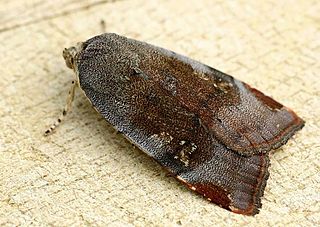
The Noctuidae, commonly known as owlet moths, cutworms or armyworms, are a family of moths. They are considered the most controversial family in the superfamily Noctuoidea because many of the clades are constantly changing, along with the other families of the Noctuoidea. It was considered the largest family in Lepidoptera for a long time, but after regrouping Lymantriinae, Catocalinae and Calpinae within the family Erebidae, the latter holds this title now. Currently, Noctuidae is the second largest family in Noctuoidea, with about 1,089 genera and 11,772 species. This classification is still contingent, as more changes continue to appear between Noctuidae and Erebidae.

Notodontidae is a family of moths with approximately 3,800 known species. The family was described by James Francis Stephens in 1829. Moths of this family are found in all parts of the world, but they are most concentrated in tropical areas, especially in the New World.

Agrotis segetum, sometimes known as the turnip moth, is a moth of the family Noctuidae. The species was first described by Michael Denis and Ignaz Schiffermüller in 1775. It is a common European species and it is found in Africa and across Eurasia except for the northernmost parts.

The Catocalinae are a subfamily of noctuoid moths, placed in family Noctuidae. In the alternative arrangement, where the Noctuidae are reduced to the core group around the Noctuinae, the present lineage is abolished, the upranked Catocalini being merged with the Erebini and becoming a subfamily of the reestablished family Erebidae.

Catocala is a generally Holarctic genus of moths in the family Erebidae. The genus was erected by Franz von Paula Schrank in 1802. The moths are commonly known as underwing moths or simply underwings. These terms are sometimes used for a few related moths, but usually – especially when used in plural, not as part of a species name – they are used to refer to Catocala only.

Xestia is a genus of noctuid moths. They are the type genus of the tribe Xestiini in subfamily Noctuinae, though some authors merge this tribe with the Noctuini. Species in this genus are commonly known as "clays", "darts" or "rustics", but such names are commonplace among Noctuidae. Xestia moths have a wide distribution, though they most prominently occur in the Holarctic.

Noctua is a genus of moths. They have dull, cryptic forewings and often very bright hindwings. These are hidden under the forewings when the moths rest, leading to their common name of yellow underwings. They are not particularly closely related to the "true" underwing moths (Catocala) though, apart from both being Noctuoidea. They are good fliers.

The Herminiinae are a subfamily of moths in the family Erebidae. The members of the subfamily are called litter moths because the caterpillars of most members feed on dead leaves of plants, though others feed on living leaves, and/or the mushrooms of fungi as in the case of genus Idia.

The Calpini are a tribe of fruit-piercing moths in the family Erebidae; formerly they were included in the family Noctuidae. The proboscis of the adult moths of this tribe is pointed and barbed, allowing the moth to pierce the skin of fruit to drink the juice. The vampire moths in the genus Calyptra can pierce mammal skin to drink blood.

Cybosia is a monotypic moth genus in the subfamily Arctiinae erected by Jacob Hübner in 1819. Its only species, Cybosia mesomella, the four-dotted footman, was first described by Carl Linnaeus in his 1758 10th edition of Systema Naturae.

Dysauxes is a genus of moths in the family Erebidae. The genus was erected by Jacob Hübner in 1819.

Acronicta rumicis, the knot grass moth, is a species of moth which is part of the genus Acronicta and family Noctuidae. It was first described by Carl Linnaeus in his 1758 10th edition of Systema Naturae. It is found in the Palearctic region. A. rumicis lives and feeds on plants located in wide-open areas. At its larval stage, as a caterpillar, it causes such a large impact as a crop pest that it has received much attention and research. A. rumicis feeds on maize, strawberries and other herbaceous plants.

Cryphia is a genus of moths of the family Noctuidae. The genus was erected by Jacob Hübner in 1818.

Zanclognatha is a genus of litter moths of the family Erebidae. The genus was erected by Julius Lederer in 1857.

Itmaharela is a genus of moths of the family Noctuidae.

Drasteria is a genus of moths in the family Erebidae.

Euparthenos is a monotypic moth genus in the family Erebidae erected by Augustus Radcliffe Grote in 1876. Its only species, Euparthenos nubilis, the locust underwing, was first described by Jacob Hübner in 1823. The adults resemble some of the underwing moths of genus Catocala, which are fairly close relatives, in color, pattern, and the habit of resting on tree trunks. But E. nubilis can usually be immediately recognized by the four concentric black bands per hindwing, as opposed to one or two in Catocala. Color morphs of E. nubilis with altered pattern are known, however, and these may be hard to recognize without detailed examination.

The Erebidae are a family of moths in the superfamily Noctuoidea. The family is among the largest families of moths by species count and contains a wide variety of well-known macromoth groups. The family includes the underwings (Catocala); litter moths (Herminiinae); tiger, lichen, footman and wasp moths (Arctiinae); tussock moths (Lymantriinae), including the arctic woolly bear moth ; fruit-piercing moths ; micronoctuoid moths (Micronoctuini); snout moths (Hypeninae); and zales, though many of these common names can also refer to moths outside the Erebidae. Some of the erebid moths are called owlets.

Nudorthodes is a genus of moths of the family Noctuidae erected by J. Donald Lafontaine, J. Bruce Walsh and Clifford D. Ferris in 2014.



















